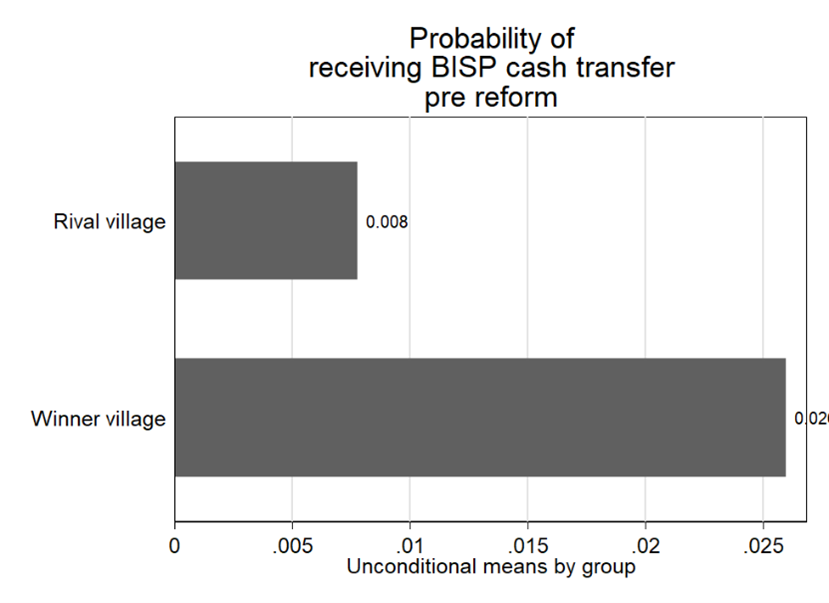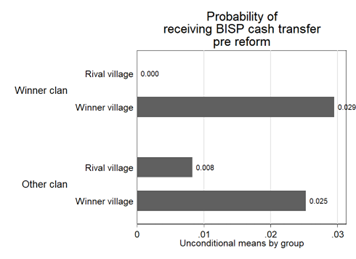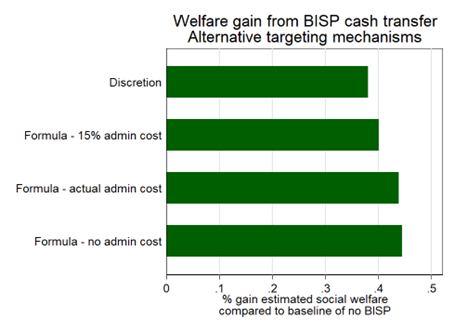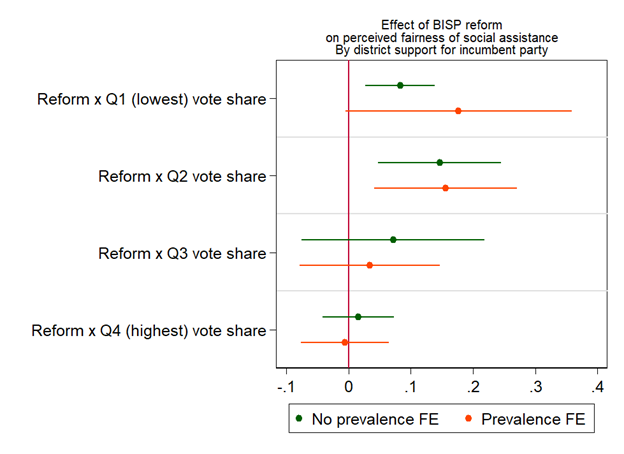
Data-driven targeting can make social assistance less subject to favouritism, more pro-poor, and more politically sustainable
Governments have expanded targeted social assistance programs to hundreds of millions of recipients worldwide; these programs continue to expand (World Bank 2018). Previous work featured on VoxDev has highlighted some of the extensive research demonstrating benefits of targeted assistance programs, including in-kind transfers (Phadera et al. 2022, Bedoya et al. 2022) and conditional cash transfers (Attanasio et al. 2023, Gerard et al. 2022).
However, determining eligibility for such programs is challenging in poor countries, where budgets are too limited to make them universal, and means testing is complicated because most of the poor’s work is informal and their income and assets are not documented. In the absence of centralised administrative data, low-income countries may have to leave the selection of recipients at least in part to the discretion of individual officials. Through the early 2000s, many social protection programs used some form of community based targeting, which often relies on discretion of individual officials (McCord 2013). However, a number of studies demonstrate favouritism in programs using community based targeting (Conning and Kevane 2002, Mansuri and Rao 2004, Caeyers and Dercon 2012, Pan and Christiaensen 2012).
Aid donors have pushed for data-driven targeting, but this could have advantages and disadvantages
Donor agencies such as the World Bank have supported the development of administrative databases and formula-based targeting systems for social protection worldwide; by 2015, over 160 social protection programs used proxy means tests to target recipients (Weible et al. 2015). However, some have argued that discretionary targeting has benefits as compared to strict formula based targeting: an official with discretion to select recipients might be able to access more information about these households than a central bureaucracy would collect, e.g. through observation or through his social network. He might use this information to select recipients who are poor but would not qualify based on noisy eligibility proxies (Conning and Kevane 2002, Bardhan and Mookherjee 2000, 2005, Niehaus et al. 2013, Alatas et al. 2012, Basurto et al. 2020, Alderman 2002, Hussam et al. 2018). In addition, in developing countries, where information on income and assets is difficult to verify, these administrative databases still only contain proxies for poverty; this leads to error in targeting (Brown et al. 2018, AusAID 2011). Thus, the overall effect of the large scale effort to replace targeting based on discretion with targeting based on data is uncertain. Yet studies that can isolate the effect of data-driven versus discretionary targeting are still rare.
The rollout of data-driven targeting in Pakistan’s transfer system allows us to quantify the impacts of data-driven targeting
In Haseeb and Vyborny (2022) (published version, ungated version), we quantify the effects of replacing discretion with administrative data in a public assistance program. We study a nationwide overhaul of Pakistan’s social assistance program, the Benazir Income Support Program (BISP), an unconditional cash transfer to millions of households across the country. Before the reform, elected officials were given discretion to identify poor households for the cash transfer program. The World Bank and other donor agencies worked with reformers in the government of Pakistan to create a new national administrative database of households and their assets, and to use it to replace this discretionary targeting system with data-driven (proxy means test) targeting. Over this period, the target population, the value of the transfer per household, and payment mechanisms for the transfer remained the same, allowing us to isolate the effects of the introduction of administrative data for targeting the transfer. We document three benefits of the new data-driven system.
Data-driven targeting reduced favouritism towards households connected to elected officials
We survey households in the origin villages of elected officials and a similar comparison group, the origin villages of their rivals. These two groups of households are similar in terms of wealth, demographics and geography, and differ only in whether they are connected to an elected official currently holding office. We compare the transfers received by these two groups of households, before and after the reform. We find that replacing discretion with data-driven targeting reduced favouritism for households connected to elected officials. Before the reform, households from the origin villages of elected officials were far more likely to receive cash transfers than those from the villages of rival politicians – particularly those from the official’s clan (Figure 1). After the reform, favouritism for the official’s clan in his origin village disappears. Some favouritism remains, but the data suggest it represents officials assisting eligible households connected to them to get through the administrative process of receiving the program.
Figure 1: Probability of receiving BISP cash transfer pre reform


Data-driven targeting made BISP more pro-poor
As the reform rolled out, targeting became more pro-poor across the province by a range of poverty measures. We use survey data to simulate household expenditure under different targeting approaches, and calculate that the improvements in targeting increase the welfare gains from the cash transfer program by 15%. This benefit was seven times as large as the reported administrative costs of the reform (Figure 2).
Figure 2: Welfare gain from BISP cash transfer: Alternative targeting mechanisms

Data-driven targeting improved public perceptions of social assistance programs, which may have contributed to the program’s continuation and expansion despite two changes in national political leadership
The rollout of the reform increased positive perceptions of social protection programs by 40%. Approval of social protection increased not only among households that might benefit from it, but also among the wealthiest households (who were less likely to receive benefits after the reform). This is important because targeted social assistance programs typically benefit a small fraction of households; thus to be politically sustainable, they may require support from many non- beneficiaries. In addition, perceptions of the program improved more in political opposition areas (Figure 3).
This improvement in perceptions across wealth levels and across the political landscape may have contributed to the survival of the cash transfer program through two subsequent political transitions. Observers expected the program might be rolled back after the party that initiated the program lost power (Sarwar 2018), as historically governments in Pakistan have often de-funded social assistance programs established by their predecessors, and added new programs alongside them. This kind of program instability is costly, because of higher administrative costs in setting up new programs and because income support transfers likely have lower benefits as a “safety net” against shocks if they are unreliable (Bazzi et al. 2015). Breaking with this pattern, each new party kept the program’s features and simply changed its branding. Not only this, they increased funding to the cash transfer program, initiated a round of updating the administrative dataset and expanded its use for other targeted programs.
Figure 3: The effect of BISP reform on perceived fairness of social assistance: By district support for incumbent party

Main policy takeaway: administrative data as an investment in institutional capacity
Our results show that data-driven targeting can make cash transfers less subject to favouritism and more pro-poor. We also find that making distribution fairer can also make it more politically sustainable. This suggests that governments and donors should look at investments in administrative data systems as investments in institutions – they may make government programs more politically stable, continuous and effective in the long run.
References
Alatas, V, A Banerjee, R Hanna, B A Olken, and J Tobias (2012), “Targeting the Poor: Evidence from a Field Experiment in Indonesia.” American Economic Review, 102(4): 1206–1240.
Alderman, H (2002), “Do local officials know something we don’t? Decentralization of targeted transfers in Albania.” Journal of Public Economics, 83(3): 375–404.
Attanasio, O, L Cardona Sosa, C Medina, C Meghir, C Posso, B Taboada (2023), “The long-term effects of conditional cash transfer programmes: Evidence from Colombia”, VoxDev, Available here.
AusAID (2011), “Targeting the Poorest : An assessment of the proxy means test methodology.”
Bardhan, P and D Mookherjee (2000), “Capture and Governance at Local and National Levels.” American Economic Review, 90(2): 135–139.
Bardhan, P and D Mookherjee (2005), “Decentralizing antipoverty program delivery in developing countries.” Journal of Public Economics, 89(4): 675–704.
Basurto, M P, P Dupas and J Robinson (2020), “Decentralization and efficiency of subsidy targeting: Evidence from chiefs in rural Malawi.” Journal of Public Economics, 185: 104047.
Bazzi, S, S Sumarto and A Suryahadi (2015), “It’s all in the timing: Cash transfers and consumption smoothing in a developing country.” Journal of Economic Behavior and Organization, 119: 267–288.
Bedoya G, A Coville, J Haushofer, M Isaqzadeh, J Shapiro (2022), “Evaluating the impact of the Targeting the Ultra Poor programme in Afghanistan”, VoxDev, Available here.
Brautigam, D A and S Knack (2004), “Foreign Aid, Institutions, and Governance in Sub-Saharan Africa.” Economic Development and Cultural Change, 52(2): 255–285.
Brown, C, M Ravaillon, and D van de Walle (2018), “A poor means test? Econometric targeting in Africa.” Journal of Development Economics, 134: 109–124.
Burgess, R, R Jedwab, E Miguel, A Morjaria and G Padro i Miquel, (2015), “The Value of Democracy: Evidence from Road Building In Kenya.” American Economic Review, 105(6): 1817–1851.
Caeyers, B and S Dercon (2012), “Political Connections and Social Networks in Targeted Transfer Programs: Evidence from Rural Ethiopia.” Economic Development and Cultural Change, 60(4): 639675.
Conning, J and M Kevane (2002), “Community Based Targeting Mechanisms for Social Safety Nets: A Critical Review.” World Development, 30(3).
Djankov, S, J G Montalvo and M Reynal-Querol (2008), “The curse of aid.” Journal of Economic Growth, 13(3): 169–194.
Fafchamps, M and J Labonne (2017), “Do Politicians’ Relatives Get Better Jobs? Evidence from Municipal Elections.” Journal of Law, Economics, and Organization.
Gerard F, J Naritomi and J Silva (2022), “Cash transfer programmes can stimulate the local economy: Evidence from Brazil”, VoxDev, Available here.
Haseeb, M and K Vyborny (2022). “Data, discretion and institutional capacity: Evidence from cash transfers in Pakistan.” Journal of Public Economics.
Hickey, S (2008), Conceptualising the Politics of Social Protection in Africa. In A. Barrientos and D. Hulme (eds.), Social Protection for the Poor and Poorest: Concepts, Policies and Politics.
Hodler, R and P A Raschky (2014), “Regional Favoritism.” Quarterly Journal of Economics, 995 – 1033.
Hussam, R, N Rigol and B Roth (2018), “Targeting High Ability Entrepreneurs Using Community Information: Mechanism Design In The Field.” Working paper, Harvard Business School.
Mansuri, G and V Rao (2004), “Community-Based and -Driven Development: A Critical Review.” The World Bank Research Observer, 19(1): 1–39.
McCord, A (2013), “Community-based targeting in the Social Protection sector.” ODI Working Paper.
Moss, T, G Pettersson and N van de Walle (2006), “An Aid-Institutions Paradox? A Review Essay on Aid Dependency and State Building in Sub-Saharan Africa.” Center for Global Development Working Papers, (74), 1–28.
Niehaus, P, A Atanassova, M Bertrand, and S Mullainathan (2013), “Targeting with Agents.” American Economic Journal: Economic Policy, 5(1): 206–238.
Pan, L and L Christiaensen (2012), “Who is Vouching for the Input Voucher? Decentralized Targeting and Elite Capture in Tanzania.” World Development, 40(8): 1619–1633.
Phadera, L, H Michelson, A E Winter-Nelson and P D Goldsmith (2022), “Do asset transfers build household resilience?”, VoxDev, Available here.
Sarwar, M B (2018), “The political economy of cash transfer programmes in Brazil, Pakistan and the Philippines.” ODI Working Paper 543.
Weible, K, T Boger, J Berten, M von Gliszczynskiand L Leisering (2015), “FLOORCASH.” Research Project FLOOR (FloorCash).
World Bank (2018). The State of Social Safety Nets 2018.


